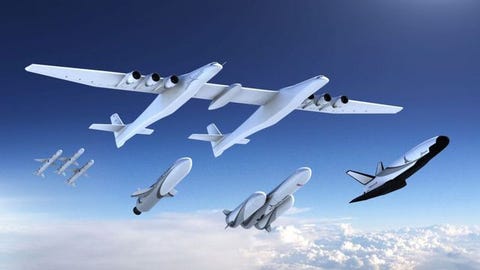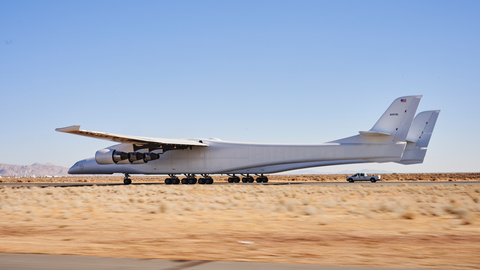Stratolaunch Has a New Spaceplane, and It's Designed With Humans in Mind
The design of its megaplane made it ideal for satellite launches, but its new cargo could be humans.
By Joe Pappalardo STRATOLAUNCH SYSTEMS
STRATOLAUNCH SYSTEMSWhen you see a plane with a 385-foot wingspan that can launch rockets mid-flight, it's hard not to get excited about human ingenuity when it comes to reaching space.
Now Stratolaunch Systems, the maker of that beastly megaplane (also named Stratolaunch), is giving the world a closer look at the rockets it will launch —and one of them will even carry humans.
A New Kind of Cargo

STRATOLAUNCH SYSTEMS
Stratolaunch's design is perfect for launching satellites. Its air launch system lowers fuel costs by ferrying payloads to high altitudes before launching them into orbit, and Stratolaunch is now doubling down on that plan by offering customers rides on an ambitious family of large rockets.
The company says it will use four different vehicles to launch satellites. The first will use the venerable Pegasus rocket in 2020 but with new, larger rockets coming online in the years after. A Medium Launch Vehicle will have a payload capacity of 7,500 pounds, much larger than the Pegasus’ 815-pound limit, and may be ready in 2022, the company says. A heavier version is scheduled as well.
"GETTING YOUR SATELLITE INTO SPACE WILL SOON BE AS EASY AS BOOKING AN AIRLINE FLIGHT."
These larger rockets means Stratolaunch will loft more expensive, vital sats into orbit. "Whatever the payload, whatever the orbit, getting your satellite into space will soon be as easy as booking an airline flight," said Stratolaunch CEO Jean Floyd.
Stratolaunch officials always maintained that the company wanted to fly people, but those plans have finally been released. The forth rocket is attached to a spaceplane that could carry passengers.
A Pilotless People Carrier

STRATOLAUNCH SYSTEMS
A resueable, winged spacecraft is an ideal emergency response vehicle, either to deliver a replacement satellite into space or turning the spacecraft into a satellite itself. The USAF X-37B unscrewed spaceplane is in orbit now, doing these things under a cloak of secrecy.
But Stratolaunch is much more overt about their new spaceplane, saying it will be able to bring payloads up and down from orbit. This would make the spaceplane a kind of delivery service hauling cargo to space stations and returning science experiments to laboratories back on Earth.
The initial spaceplane will be a pilotless drone rated for carrying people. With this human-ferrying intention stated from the start, Stratolaunch can design its spaceplane from the ground up with people in mind. Similarly, SpaceX saved lots of time by designing its space cargo-carrying capsules to accommodate humans from the start.
But Stratolaunch's human cargo ambitions are also its most distant as the spaceplane is only in the design phase. As with many space-related projects, this plan is still easily susceptible to change, delays, or cancellation. But another private space company announcing its plan to carry humans into space sends ripples throughout the industry.
Filling in a Vacancy

A plaque commemorating the final shuttle flight, which landed at Cape Canaveral's Shuttle Launch Facility in 2011.
POPULAR MECHANICS
Those ripples often reach Florida first.
The Stratolaunch system is supposed to operate from Kennedy Space Center, using the long “runway at the edge of tomorrow.” The facility is in dire need of tenants, and having missions start and stop from there would be lifesaver. Because the massive plane flies over the Atlantic to launch, away from vertical pads, Stratolaunch wouldn't clog up the existing lauchpads, making it a good fit at Cape Canaveral.
With so many new spaceports cropping up across the U.S. (and the world), the Stratolaunch could have many homes. In fact, just this week Front Range airport became the nation’s 11th FAA-designated spaceport. These designated spaceports are eager to attract air-launched rocket companies, but because of the Stratolaunch's sheer size, playing host the world's largest airplane isn't an easy job.
However, new spaceplanes could mean opportunity for some spaceports. Unlike rockets, spaceplanes can land anywhere. For example, Stratolaunch could land at a spaceport in Colorado and unload scientific experiments for researchers working for Denver-based companies.
But this spaceplane has always been at the center of Stratolaunch. The company's founder Paul Allen said in 2012 that Stratolaunch “will give us orbital access to space with greater safety, flexibility, and cost effectiveness, both for cargo and manned missions."
It looks like Stratolaunch is getting closer to delivering on that promise.
No comments:
Post a Comment